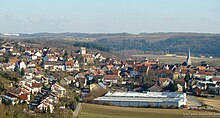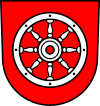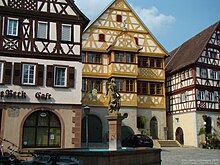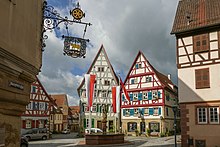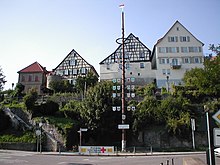Neudenau
| coat of arms | Germany map | |
|---|---|---|

|
Coordinates: 49 ° 18 ' N , 9 ° 16' E |
|
| Basic data | ||
| State : | Baden-Württemberg | |
| Administrative region : | Stuttgart | |
| County : | Heilbronn | |
| Height : | 189 m above sea level NHN | |
| Area : | 32.92 km 2 | |
| Residents: | 5266 (December 31, 2018) | |
| Population density : | 160 inhabitants per km 2 | |
| Postal code : | 74861 | |
| Primaries : | 06264, 06298 | |
| License plate : | HN | |
| Community key : | 08 1 25 068 | |
| LOCODE : | DE NDA | |
| City structure: | Core city, 4 districts | |
City administration address : |
Hauptstrasse 27 74861 Neudenau |
|
| Website : | ||
| Mayor : | Manfred Hebeiß ( CDU ) | |
| Location of the city of Neudenau in the Heilbronn district | ||
Neudenau [ ˈnɔʏ̯dənaʊ̯ ] (in local dialect Neidene ) is a town and a sub-center in the district of Heilbronn in Baden-Württemberg ( Germany ). It belongs to the Heilbronn-Franconia region (until May 20, 2003 Franconia region ) and the peripheral zone of the European metropolitan region of Stuttgart .
geography
Neudenau is located in the northeastern district of Heilbronn an der Jagst .
Neighboring communities
Neighboring towns and communities in Neudenau are ( clockwise , starting in the north): Billigheim ( Neckar-Odenwald district ), Möckmühl , Hardthausen am Kocher , Neuenstadt am Kocher , Bad Friedrichshall and Gundelsheim (all districts of Heilbronn).
City structure
Neudenau is divided into the city of Neudenau itself and the districts of Herbolzheim and Siglingen . The residential area St. Gangolfskapelle (the last remnant of the abandoned village of Deitingen) belongs to Neudenau itself, the hamlets of Kreßbach and Reichertshausen belong to Siglingen . Places that have passed and no longer exist today are on the markings Neudenau Leichtenweiler and Deitingen , on the markings Siglingen Neuhof and Veherbrunnen .
Division of space

According to data from the State Statistical Office , as of 2014.
history
Neudenau
Neudenau goes back to a place originally called Busingen , which was fortified by the Lords of Dürn in the early 13th century . The fortification followed the construction of Wildenberg Castle and is related to the expansion of the villages of Buchen , Forchtenberg and Walldürn, which took place around the same time . The construction of a castle in Busingen on the ledge of the northern Jagstufers was probably carried out by Konrad II of Dürn. In 1251 the place was first attested as Nidenowe , in 1263 the place is called a city.
Around 1300 the town came into the possession of the Lords of Weinsberg . A Konrad von Weinsberg sold the city in 1327 to his uncle Konrad von Hohenriet, from whom the city had already passed to Burkhard Sturmfeder in 1330 . In 1335 the Archbishop of Mainz Balduin acquired rights in Neudenau at the same time as the Scheuerberg rule . When Bishop Gerlach demanded these rights a few years later, there was a dispute with Burkhard Sturmfeder for several years, which was not settled until his death in 1364, when Neudenau and all its accessories fell to Kurmainz , where the city remained until 1802.
During the Thirty Years' War , Neudenau, like almost all the surrounding towns, suffered from billeting, troop movements and epidemics. The location on an old long-distance route between the Unterland and Würzburg along the Jagst Valley, which led to many troops moving through during wartime, was also the basis for rapid reconstruction and progress after the end of the war, as breeding cattle and seeds could easily be supplied. In Neudenau, for the first time in the region, cattle were harnessed in half yokes instead of the older double yokes, which earned the inhabitants the nickname "Halbjöcher". In 1668 there were 558 inhabitants. By 1700 the place had recovered from the previous wars to such an extent that stately town houses were built again. The plan to build a new church, however, dragged on for 23 years due to a legal dispute with the Wimpfen monastery , which was the patronage, and could only be implemented from 1742. Neudenau experienced a certain heyday in the 18th century as the Electorate of Mainz.
In 1803 Neudenau came into the possession of the Counts of Leiningen-Heidesheim and became Baden after the dissolution of the Roman-German Empire through the establishment of the Rhine Confederation in 1806 . There it belonged to the office of Mosbach, from which the district of Mosbach emerged , and sank to the insignificance of a country place. In 1840 parts of the city wall as well as the city gates and towers were removed at the instigation of the Mosbacher Oberamtmann Dr. Fauth canceled. Numerous art and architectural monuments in Neudenau can be traced back to the Merckle family, who in the 19th and early 20th centuries produced four generations of innkeepers and local councilors and, with Johann Franz Merckle (1835–1889), a mayor of the place.
In 1939 there were 1168 inhabitants, at the end of 1945 there were 1392.
Districts
According to excavations, Herbolzheim already existed in the 7th century and was first mentioned in the 9th century as Heribotesheim in the Lorsch Codex . Herbolzheim became electoral Mainz in 1361 and experienced the same change of rule as Neudenau. In 1939 Herbolzheim had 715 inhabitants, at the end of 1945 there were 788. In the course of the district reform in Baden-Württemberg in 1973 and the dissolution of the Mosbach district, Herbolzheim became part of the Heilbronn district. 1975 Herbolzheim became a district of Neudenau.
Siglingen was first mentioned in a document from the late 8th or early 9th century. Around 800 it was owned by the Fulda Monastery and before 1308 it fell to the Lords of Weinsberg . In 1445 the place became Electoral Palatinate , in 1504 Württemberg . Siglingen became part of the Neckarsulm District Office and later of the Heilbronn District . In 1939 there were 917 inhabitants in Siglingen, at the end of 1945 there were 1,058.
Neudenau and Herbolzheim have also been part of the Heilbronn district since 1973. On January 1, 1975, the city of Neudenau merged with the communities of Herbolzheim (Jagst) and Siglingen (including the districts of Kreßbach and Reichertshausen) to form the new city of Neudenau.
Religions
The residents of Neudenau and Herbolzheim are predominantly Catholic, there are the Catholic parishes of St. Laurentius in Neudenau itself and St. Kilian in Herbolzheim. In Siglingen there is a Protestant parish of St. Ulrich.
Jews from Neudenau are already mentioned in connection with the Rintfleisch pogrom in 1298 and the plague pogroms of the 14th century, but were not always resident here. In a document from 1492, the Jewish cemetery in Neudenau , which was then reopened, is already described as "had been around for a long time" so that it is one of the oldest Jewish cemeteries in southwest Germany. With the resumption of burials after 1492 a single Jew was allowed to settle in Neudenau again. In 1667 only a single Jew is mentioned. A community did not develop until around 1700. In 1769 there were 8 families with 36 people, in 1806 there were eleven families with 54 people. The Jewish community was poor and was only able to build a new synagogue that had been planned since 1820 as a replacement for a cramped prayer room in 1875. As a result of emigration and emigration, however, the Jewish community rapidly declined. In 1883 there were 50 Jews living in Neudenau, 26 in 1910, twelve in 1925 and nine in 1933, who moved to other cities after 1935 and later died in deportations from there. The religious community was dissolved on November 8, 1937, and the synagogue was destroyed in the November pogrom in 1938.
politics
Local council and local council
In Neudenau, the municipal council is elected using the spurious selection of a part of town. The number of local councils can change due to overhang mandates . The municipal council consists of the elected voluntary councilors and the mayor as chairman. The mayor is entitled to vote in the municipal council. The local elections on May 26, 2019 led to the following final result.
| Parties and constituencies |
% 2019 |
Seats 2019 |
% 2014 |
Seats 2014 |
||
| FW | Free electoral association | 60.44 | 11 | 52.7 | 11 | |
| CDU | Christian Democratic Union of Germany | 30.84 | 6th | 30.9 | 7th | |
| SPD | Social Democratic Party of Germany | 8.72 | 2 | 16.4 | 3 | |
| total | 100.0 | 19th | 100.0 | 21st | ||
| voter turnout | 60.99% | 49.2% | ||||
There is also a local council in the village of Herbolzheim. At his suggestion, the Herbolzheim municipal council elects an honorary mayor . These bodies are to be heard on important matters affecting the locality.
mayor
Manfred Hebeiß (* 1958) has been the mayor since May 1999; he was confirmed in office in 2007 and 2015.
badges and flags
|
Blazon : "An eight-spoke silver wheel in red."
The city colors are white and red. |
|
| Justification of the coat of arms: The wheel goes back to the long Electoral Mainz rule in Neudenau (1364 to 1802) and is a variant of the Mainz wheel with eight instead of six spokes. The oldest secured use was in a Neudenau seal from the 15th century, the imprints of which are documented from 1542. From 1803 to 1806 Neudenau used the three leiningen eagles of the local rule in the seal . In 1900, the Baden Ministry of the Interior approved the return to the original form. The newly formed town of Neudenau on January 1, 1975 took up the coat of arms of its predecessor of the same name; The coat of arms and flag were awarded to the city on August 16, 1978 by the district office of Heilbronn. |
Culture and sights
Buildings
The Neudenau market square is surrounded by half-timbered houses , including the town hall from 1587 and its right-hand neighboring building from 1631. The market fountain was renovated in 1828 and 1991. The entire old town of Neudenau is rich in historical half-timbered buildings dating back to the 15th century, including the Sturmfeder'sche house from 1479 near the wine press. Parts of the medieval city wall with defense towers have also been preserved.
Neudenau Castle, built from the 13th century onwards, was the seat of the Mainz cellar until 1802, after being bought by the city from 1872 to 1961, a school building and from 1933 until today also a museum.
The Catholic parish church of St. Laurentius was built on the site of a much older church from 1742 in the late Baroque style, with the tower of the previous Gothic building being taken over. At the Jagstbrücke is the late Gothic Wolfgang Chapel , which was enlarged in 1720 and where the Neudenau cemetery has been located since 1780 , which is why the building has served as a cemetery chapel since then. At the old fork in the road to Allfeld and Höchstberg, there is a distinctive cross-shaped stone Holy Cross chapel built in 1870 as a replacement for a chapel built around 1700 , which has been used by the Protestant community since a renovation in 1989.
Outside the village is the Romanesque Gangolf chapel of the village of Deitingen, which was lost in the Thirty Years War , to which a horse pilgrimage ( Gangolfsritt ) is undertaken every year on the second Sunday in May and whose doors are richly decorated with historical horseshoes. The chapel has historical wall paintings from the 14th and 15th centuries as well as ornate historical altars.
The other art monuments in Neudenau include a Mount of Olives group and a crucifixion group near the parish church and another historic crucifixion group on Lindenplatz. There are numerous historical wayside shrines in and around the village .
Museums
The Josefine-Weihrauch-Heimatmuseum in Schloss Neudenau shows exhibits from local and regional history and in summer also changing exhibitions.
Regular events
Neudenau is known regionally for the so-called Gangolfsritt, an annually recurring equestrian procession on the second Sunday in May. Every year the “Gässlesmarkt” drinking festival took place at the beginning of June, and since 2001 there has also been a parade on changing topics in partly original historical clothing.
Economy and Infrastructure
Neudenau and its neighborhoods are viticulture locations whose locations for Großlage Kochersberg in the range Kocher-Jagst Tauber of Weinbaugebietes Württemberg belong.
Between Neudenau and the Siglingen district is the Neudenau outdoor swimming pool, which celebrated its 50th anniversary in 2017. It is noteworthy that the pool is not owned by the city, but by a non-profit association.
traffic
Neudenau is located with the Herbolzheim (Jagst) , Neudenau and Siglingen stops on the railway line from Stuttgart via Heilbronn to Würzburg ( Frankenbahn ). There is an approximate hourly service in the direction of Heilbronn and in the direction of Osterburken with regional trains . The Möckmühl junction on the A 81 is 8 km away. The junction in the neighboring town of Neuenstadt is 6 km away.
media
The daily newspaper Heilbronner Voice reports on the events in Neudenau in its issue N, District North.
education
The Kurmainz School in Neudenau is a primary and secondary school with a technical secondary school . There are primary schools in Herbolzheim and Siglingen. There is also a music school in Neudenau. In addition to a municipal kindergarten in the Siglingen district, there are also two Catholic kindergartens in the main town and in Herbolzheim.
In addition, the Unterland Adult Education Center in Neudenau has a branch.
Personalities
sons and daughters of the town
- Wilhelm Schwarz (1887–1966), MdL in Baden 1930–1933, from 1945 to 1954 mayor of Mosbach
- Carola Rosenberg-Blume (1899–1987), founder and head of an institution for women's education at the Volkshochschule Stuttgart
- Bernhard Lott (1950–2008), Palatine-Franconian dialect poet
Individual evidence
- ↑ State Statistical Office Baden-Württemberg - Population by nationality and gender on December 31, 2018 (CSV file) ( help on this ).
- ↑ Source for the urban structure section: Das Land Baden-Württemberg. Official description by district and municipality. Volume IV: Stuttgart district, Franconian and East Württemberg regional associations. Kohlhammer, Stuttgart 1980, ISBN 3-17-005708-1 . Pp. 120–123 and correction in Vol. VIII, Stuttgart 1983, ISBN 3-17-008113-6 , p. 661. Additional source for Deitingen: Hartmut Gräf: Medieval and early modern desolations in the former offices of Möckmühl, Neuenstadt and Weinsberg . In: Heilbronnica. Contributions to the city and regional history . Volume 4. Heilbronn City Archives, Heilbronn 2008, ISBN 978-3-940646-01-9 ( Sources and research on the history of the city of Heilbronn . 19) ( Yearbook for Swabian-Franconian history . 36). Pp. 69-168
- ↑ State Statistical Office, area since 1988 according to actual use for Neudenau.
- ↑ a b c Communications of the Württ. And Bad. State Statistical Office No. 2: Results of the population census on December 31, 1945 in North Baden
- ^ Federal Statistical Office (ed.): Historical municipality directory for the Federal Republic of Germany. Name, border and key number changes in municipalities, counties and administrative districts from May 27, 1970 to December 31, 1982 . W. Kohlhammer, Stuttgart / Mainz 1983, ISBN 3-17-003263-1 , p. 465 .
- ↑ Preliminary results of the 2019 municipal council elections at the State Statistical Office
- ↑ Stimme.de : Mayor Manfred Hebeiß celebrates his 50th on May 21, 2008.
- ↑ LEO-BW - Neudenau
-
↑ Source for the section coat of arms and flag:
Heinz Bardua: The district and community coat of arms in the Stuttgart administrative region . Theiss, Stuttgart 1987, ISBN 3-8062-0801-8 (district and municipality coat of arms in Baden-Württemberg, 1). P. 104
Klemens Stadler: German coats of arms. Federal Republic of Germany . Volume 8: The municipal coats of arms of the state of Baden-Württemberg. Angelsachsen-Verlag, Bremen 1971. p. 76 - ↑ VHS Unterland branch offices .
Web links
- Link catalog on Neudenau at curlie.org (formerly DMOZ )




